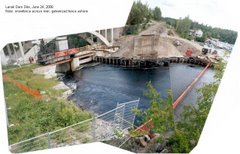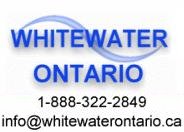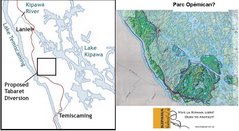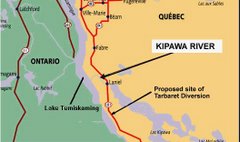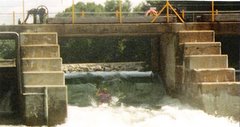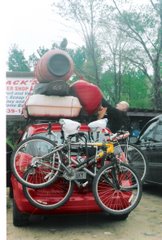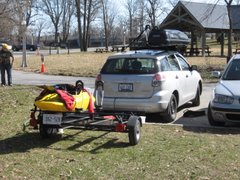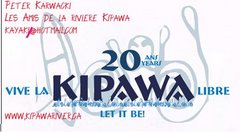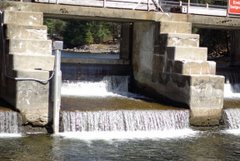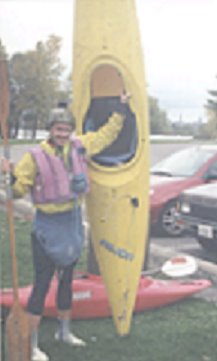Copied from CASEY breaking news...
You are receiving this sponsor-paid news release as a Casey Research
subscriber. You may opt out of these news releases at any time, by clicking here. The distribution of this news does not constitute a recommendation or advice of any kind.
PRESS RELEASE
TSX Venture: MAT
OTCQX: MHREF
Matamec Announces Results of Positive Feasibility Study for Kipawa JV Heavy Rare Earth Project
Montreal, September 4, 2013 - Matamec Explorations Inc. (“Matamec”
or the “Company”) is pleased to announce the positive results of the
Feasibility Study (“FS”) for the Kipawa Joint Venture (“JV”) Heavy Rare
Earth Elements Project (“HREE”) (“the Project”). The FS was prepared
by Roche Ltd. and GENIVAR Inc. and supported by SGS Geostat and Golder
Associates Ltd. FS results show that the Project is technically and
economically feasible. An analyst’s conference call will be held today
at 10:00 a.m. ET. All numbers are reported in Canadian dollars unless
otherwise stated.
The goal of the Kipawa JV is to supply Toyota Tsusho Corp. (“TTC”)
with heavy rare earths such as dysprosium which is indispensable for
hybrid and electric vehicles. The JV partners are presently in
discussions and evaluating next steps to advance the project.
KIPAWA HREE PROJECT – FS FINANCIAL MODEL HIGHLIGHTS
|
Net Present Value (NPV10%) (Pre-Tax)
|
$260 million
|
Internal Rate of Return (IRR) (Pre-Tax)
|
21.6%
|
Revenue
|
$2.55 billion
|
EBITDA
|
$1.37 billion
|
CAPEX (initial)
|
$374 million
|
OPEX (annual)
|
$78.5 million
|
Payback Period (Pre-Tax)
|
3.9 years
|
Life of Mine (LOM)
|
15.2 years
|
Concentrate Production (annual avg.)
|
3,653 tonnes
|
- The Company is committed to bringing the IRR above 25% by
continuing to reduce the required CAPEX and OPEX, while optimizing the
overall recovery rate.
“Matamec has achieved a major milestone today in its 16-year history
as the feasibility study shows that the Kipawa project is technically
and economically feasible,” said Andre Gauthier, President and CEO of
Matamec. “The Company has strategically developed a solid business
plan which includes a moderate CAPEX and a manageable scale of annual
tonnage while ensuring the required environmental standards are met.
With the completion of the feasibility study results, we will continue
to work with the citizens of the Temiscamingue area to present the
economic benefits this project will create for the region. Matamec is
committed to building a sustainable organization with a particular focus
on green energy applications.”
ECONOMIC SUMMARY OF 2012 PEA VERSUS 2013 FEASIBILITY STUDY RESULTS
|
Metric
|
PEA Quantity March 2012
|
FS Quantity August 2013
|
Unit
|
| Total Mine Revenue |
2.822
|
2.548
|
$ billion |
EBITDA
|
1.68
|
1.37
|
$ billion |
Pre-production Capital Expenditures (initial)
|
315.8
|
374.4
|
$ million |
| Sustaining Capital Expenditures (incl. rehab.) |
38.2
|
37.7
|
$ million |
Additional Working Capital Requirement
|
9.9
|
11.2
|
$ million |
| Mine Rehabilitation Costs |
7.5
|
23.1
|
$ million |
| Total Operating Costs |
1.142
|
1.181
|
$ billion |
| Total Before-tax Cash Flow |
1.335
|
960
|
$ million |
| Total Basket Price after discount |
42.08
|
50.12
|
$ /kg |
|
HREO* Basket Price - concentrate |
-
|
39.79
|
$ /kg |
|
LREO** Basket Price - concentrate |
-
|
10.33
|
$ /kg |
| Economics (Pre-Tax) |
|
|
|
|
IRR |
36.9
|
21.6
|
% |
|
NPV @ (PEA 5%) (FS 6%) |
811
|
450
|
$ million |
|
NPV @ 8% |
606
|
344
|
$ million |
|
NPV @ 10% |
500
|
260
|
$ million |
|
NPV @ 12% |
-
|
191
|
$ million |
Payback Period
|
2.4
|
3.88
|
years |
| Economics (After-Tax) |
|
|
|
|
IRR |
-
|
16.8
|
% |
|
NPV @ (PEA 5%) (FS 6%) |
-
|
257
|
$ million |
|
NPV @ 8% |
-
|
185
|
$ million |
|
NPV @ 10% |
-
|
128
|
$ million |
|
NPV @ 12% |
-
|
81
|
$ million |
Payback Period
|
-
|
4.12
|
years |
| Mining |
|
|
|
|
Mineral reserves |
19.00
|
19.77
|
millions of tonnes |
|
Production rate (ore) |
4,110
|
3,650
|
tonnes per day |
|
Life of Mine |
12.9
|
15.2
|
years |
| Total CAPEX (based on 3,653 tpa) |
86.50
|
102.57
|
$ /kg (+18%) |
| Total OPEX (based on 3,653 tpa) |
24.44
|
21.53
|
$ /kg (-13%) |
| Total Operating Costs |
24.44
|
21.53
|
$ /kg |
|
General and Administration
|
8.84
|
11.6
|
$ million per year
|
|
Mining |
16.61
|
18.1
|
$ million per year
|
|
Process |
58.35
|
48.7
|
$ million per year
|
| Total Recovery Rate*** |
81
|
70
|
% |
|
Heavy average |
-
|
74
|
% |
|
Light average |
-
|
65
|
% |
*HREO – Heavy Rare Earth Oxide (Sm, Eu, Gd, Er, Tb, Dy, Ho, Yb, Tm, Lu and Y).
**LREO – Light Rare Earth Oxide (Ce, La, Nd and Pr).
***Samples used for PEA represent only the Western part of the deposit whereas FS samples represent the whole deposit.
KIPAWA JV FEASIBILITY STUDY RESULTS HIGHLIGHTS
|
Environmental and Permitting Process
A complete environmental baseline study will be finalized by
fall 2013; Environmental and Social Impact Assessment is subjected to
the Canadian Environmental Assessment Agency, which will be
available Q1 2014. The project notice to begin the Federal
environmental permitting process was submitted before the end of Q1
2013 and the official application for the Certificate of
Authorization to the Provincial “Ministère du Développement durable,
de l’Environnement, de la Faune et des Parcs” (MDDEFP) is planned to
be submitted by winter 2014.
|
Social Acceptability
Since 2009, Matamec has been committed to engaging the
Temiscamingue communities to include and take into consideration
their concerns in the development of the Project.
|
Mineral Resource Estimates
Total measured and indicated resource now stands at 23.857
million tonnes at 0.407% Total Rare Earth Oxide (TREO) representing
88% of total resource.
|
Mineral Reserve
Mine – total projected ore tonnage is 19.8 million tonnes with a TREO diluted grade of 0.4105%.
|
Mining
Projected to produce an avg. 1.33 million tonnes of ore per
year (3,650 tonnes per day) and avg. stripping ratio of 0.94 with
15.2 years mine life (excluding pre-production period).
|
Metallurgical Plant Site
The final products of the process plant will be a chloride
concentrate of HREE and a concentrate of LREO. FS results show a
lower recovery compared to the PEA study, but it also shows that the
process is working for the entire ore body, and highlights where the
process has to be optimized in order to improve the recovery. From the
previous results, a new Master Composite of ore is ready for further
piloting planned for fall 2013 to improve the process.
|
PROJECT DEVELOPMENT – PLANNED NEXT STEPS
|
Milestone
|
Timeline
|
Second Pilot Plant
|
Fall 2013
|
Environmental and Social Impact Study
|
Q1 2014
|
Environmental Process – Federal and Provincial
|
Now to Q1 2015
|
Development of off-take agreement
|
2014
|
Financing CAPEX Process
|
2014
|
Detailed Engineering
|
2014 to mid-2015
|
Construction of Mine
|
Q1 2015 to Q4 2016
|
Start-up of Mining Operation
|
Q4 2016
|
Mr. Gauthier commented, “The Company will work with government
authorities to ensure that all required areas are covered to receive
environmental permits. We have assembled a highly qualified team who
are focused on identifying every risk possible to ensure the
environment is given the utmost respect and protected for future
generations. The Company will continue its outreach efforts with the
community which we have been developing over the past four years to
create greater comprehension and visibility for the project. We
welcome and value the concerns of the citizens of the Temiscamingue
region and look forward to working together in building a sustainable
plan.”
Additional Upside Opportunities for the Kipawa Mine Project
Matamec has identified a number of opportunities that have the potential to add additional value to the project.
- The second metallurgical pilot plant testwork should be
conducted in addition to the bench scale and first pilot plant testwork
conducted up to now. This second pilot plant testwork will be
important to confirm, prior to detailed engineering, final sizing of
some process equipment. For the time being overcapacities have been
built into the design, but it could be reduced during the detailed
engineering, pending the pilot plant results. The second pilot plant
will also help to confirm improvements in regards of recovery rates
since conservative numbers were used for the FS.
- It would be significant to consider some testworks to separate
individual Rare Earths (RE) to increase the value of the project.
- Depending on the RE market conditions, it will be important to
continue the evaluation of other LREE concentrates and HREE
concentrates production scenarios in order to optimize the IRR before
detailed engineering.
- In the future and when the project is well in progress, testwork
can be performed to evaluate the possibility to recovering zirconium
and other minor metal by-products in the RE mineralized zones and in the
syenite body.
- Mineral resources on the Kipawa deposit can be increased by verification of lateral and down dip extensions by drilling.
- From the last results in the FS it is known that there is the
potential room for improvement in the open pit design when entering the
detailed engineering phase.
Considering the above mentioned points, the Company strongly
believes it can achieve greater success with bringing the IRR above 25%
by only slightly reducing the CAPEX and OPEX while improving the
recovery.
Review of the FS Project Development Model
The FS covers all aspects of project development, including mining,
mineral concentration, hydrometallurgical processing and separation of
heavy and light rare earth as well as all related infrastructure.
Roche developed its capital and operating cost estimates from first
principle capital quotations, estimates from suppliers, manufacturers,
contractors and experience based on comparable operations in Canada and
abroad. The capital and operating cost estimates were completed to a
level consistent with an intended level of accuracy of ± 15%.
Project Location
The Kipawa deposit is located on the Zeus Property (see map below),
50 km east of the town of Temiscaming and 140 km south of
Rouyn-Noranda, Quebec. All claims are in good standing. Resources are
not subject to any third party royalties.
General Project Infrastructure Description
About 50 km of the Maniwaki road will be used to access the Kipawa
Project and share with public and other logging companies. Then a 4
km road will be built from the Maniwaki road to reach the process plant
site.
The Kipawa mining site will consist of the open pit mine, a waste
dump, a low grade stockpile and a high grade truck loading facility.
The mine equipment maintenance facility will also be located at the
mine site.
The metallurgical process plant site will be located south of the
mine site and south of the Kipawa River and a 10 km haul road will be
built to link the two sites. The metallurgical site will consist of the
ore process plant which will combine the crushing, grinding, magnetic
separation and hydrometallurgical circuits. At this site, there will
also be the administration and service building, a warehouse and the
assay laboratory.
There will be two dewatered tailing storage facilities; one storage
facility will be for the rejects of the magnetic separation process
located just by the process plant and one other storage facility for
the hydrometallurgical tailing located about 4 km south of the process
plant.
The employee’s parking and the main electrical sub-station will be
located near the town of Temiscaming. In the present study it is
planned to build a 44kV power line along the Maniwaki logging road to
provide power to the mining and processing facilities.
Geology, Mineralogy and Mineralization
The ore deposit is defined by three enriched horizons within the
“Syenite Complex”, which contains the fifteen rare earths elements
present. The Kipawa Alkaline Intrusive Complex consists of peralkaline
syenite and granite on average is less than 200 metres thick. It’s an
elongated, V-shaped body folded around a major southeast plunging
anticline. The west limb of this fold includes the Kipawa deposit,
which is entirely included within the lower syenite layer of the
complex. This mineralized syenite layer is a concordant sheet 50 to 80
meters thick that gently dips 20 to 30 degrees to the south-west. The
deposit outcrops over 1.4 km along strike with an additional outcrop
discovered 220 m to the north-west during the summer 2011 exploration
campaign.
Rare earth-yttrium-zirconium mineralization at the Kipawa deposit is
contained in medium grained silicate minerals. Grains are distinct and
generally well crystallized. Three minerals are presently considered
economical in the Kipawa deposit, namely eudialyte (a sodic silicate),
yttro-titanite/mosandrite (titanite silicate) and britholite (calsic
silico-phosphate) for the rare-earth and yttrium, with minor amounts of
apatite also present. Vlasovite/gittensite (sodic silicates) and
eudialyte (sodic silicate) are also considered for a potential
zirconium by-product.
Three vertically-stacked mineralized zones have been defined based
on their spatial characteristics: the Eudialyte (60% of existing rare
earth-yttrium resources), Mosandrite (25% of existing rare
earth-yttrium resources) and Britholite (15% of existing rare
earth-yttrium resources) zones. Despite their name, the different zones
contain a mix of the potentially economic minerals. The name simply
indicates the dominant REE mineral present in that zone. The main
Eudialyte zone, for example, consists of intermixed eudialyte (51%) and
mosandrite/yttro-titanite (39%) with trace britholite (10%). It sits
near the top of the syenite body and is not associated with any large
calco-silicate horizon. Note that all zones outcrop at surface.
The Kipawa deposit contains very low-levels of uranium and thorium
in the main REE-Zr mineralization. Average values of Th (193 ppm, or
0.019%) and especially U (22 ppm, or 0.002%): though higher than in the
surrounding rocks remains very low in the mineralized syenite portion
of the Kipawa deposit. Initial results suggest that most of the
thorium is contained in coarse-grained urano-thorite and ekanite
crystals, while the uranium is disseminated within said urano-thorite
and rare-earth minerals.
The terms “Mineral Resource” and “Mineral Reserve” are defined in the
CIM Definition Standards - For Mineral Resources and Mineral Reserves adopted by the CIM council of the Canadian Institute of Mining, Metallurgy and Petroleum.
Mineral Resources
The Kipawa Deposit resource are 10,478,000 tonnes at 0.46% TREO in
the measured category, 13,379,000 tonnes at 0.36% TREO in the indicated
category and 3,268,000 tonnes at 0.31% TREO in the inferred category.
The total of measured and indicated resource now stands at 23,857,000
tonnes at 0.41% TREO representing 88% of the total resource. These
results are at a 0.2% TREO cut-off and are not limited by an open pit.
The overall total tonnage is about 10% greater than the last resource
calculation (see press releases dated June 30 and July 7, 2011).
The Kipawa deposit’s mineral resource estimates were updated by SGS
Geostat. The drilling done since the 2011 PEA (see press release dated
January 30, 2011) totaling 14,293 m was included and permitted to
outline some measured resources for the first time in the history of
the project. The database now totals 293 drill holes totaling 24,571 m
and 13 trenches totalling 631 m. Historical Unocal holes are not in the
count and were not used for the estimates. The mineralized zones were
interpreted on vertical sections and meshed into volumes as per
industry standards. Ordinary Kriging was used to estimate the block
model with block size set at 10 m x 5 m x 5 m. The measured and
indicated resources required drill grids of 25 m and 50 m,
respectively. Resources extrapolated beyond 30 m of those drill grids
are considered inferred.
Mineral Reserves
By using SGS Geostat model, the mineral reserve for this FS was
prepared, estimated and supervised by Roche using a cut-off value of
$48.96/t with 5% dilution and a mining recovery of 95.2%. The Kipawa
open-pit design utilized a marginal (or milling) cut-off value of
$48.96/t and a break even cut-off value of $60.70/t. Included in the
reserves are 632,000 tonnes of low grade material lying between these 2
cut-offs values. This material will be sent to a low grade stockpile,
close to the mine site and will be processed at the end of operation
after mine depletion.
In-pit Mineral Reserves
|
Metric Tonnes
|
Proven (51.7% of the deposit)
|
10,219,000
|
Probable (48.3% of the deposit)
|
9,550,000
|
Total
|
19,769,000
|
|
|
Total Grade
|
|
Cerium (Ce2O3)
|
0.1195
|
Lanthanum (La2O3)
|
0.0588
|
Praseodymium (Pr6O11)
|
0.0146
|
Neodymium (Nd2O3)
|
0.0550
|
Samarium (Sm2O3)
|
0.0123
|
Europium (Eu2O3)
|
0.0015
|
Gadolinium (Gd2O3)
|
0.0119
|
Terbium (Tb4O7)
|
0.0022
|
Dysprosium (Dy2O3)
|
0.0147
|
Holmium (Ho2O3)
|
0.0032
|
Erbium (Er2O3)
|
0.0101
|
Thulium (Tm2O3)
|
0.0016
|
Ytterbium (Yb2O3)
|
0.0096
|
Lutetium (Lu2O3)
|
0.0013
|
Yttrium (Y2O3)
|
0.0943
|
TREO
|
0.4105
|
Design Basis
The Total Rare Earth Oxides (TREO) diluted grade is 0.4105%
including a dysprosium (Dy2O3) diluted grade of 0.0147%. The
calculation is using a dilution grade of 0.093% TREO. The recoveries
for each element vary from 65% to 74% for a TREO average of 70% for the
10 main REO which are (La2O3, Ce2O3, Pr6O11, Nd2O3, Sm2O3, Eu2O3,
Gd2O3, Tb4O7, Dy2O3 and Y2O3). A total production of TREO is expected
to be 55,529 tonnes over the mine life. When the mine will be in full
production (year 2-15) an average of 3,760 tonnes per year of TREO will
be produced.
Mining
The mine will produce an average of 1,332,250 tonnes of ore per year
(3,650 tonnes per day) and has an average stripping ratio (waste : ore
- without the overburden) of 0.94 with a mine life of 15.2 years. A
standard 55 tonne mining truck and shovel operation will bring the
drilled and blasted material out of the mine to their respective
destinations (waste dump, low grade stockpile or high grade loading
facility). Then the ore is transported by 40 tonne HD dump trucks to
the metallurgical plant site.
Processing
Once at the metallurgical plant site, the ore will be dumped into a
crusher dump hopper feeding a two stage crushing circuit. The crushed
ore will then be stored into a silo. The crushed ore will feed the
process plant at the rate of 3,650 tpd in a single stage grinding
circuit. A magnetic separation circuit will recover the rare earth as a
first concentrate. The reject from the mag-sep circuit will be pumped
to the dewatering circuit and transported by truck to the mag-sep
rejects storage facility located outside and nearby the process plant.
The magnetic rare earth concentrate will be sent into the regrind mill
followed by a thickening circuit and then to the hydrometallurgical
process (acid leaching, neutralization, impurities removal and the
final precipitation) will then produce the rare earth carbonate
concentrates. This hydromet concentrate will then be processed through a
purification circuit which will remove the last impurities and also
separate the h
eavies
from the lights. The final products of the process plant are a
concentrate of heavy rare earth and a concentrate of light rare earth.
The tailings produced from the hydrometallurgical process will be
pumped to a thickening facility located by the hydromet tailings
storage facility (TSF). The solids will be dewatered in few steps using
different technologies and then transported by truck and disposed
mechanically into the TSF. This TSF is thus believed to be subject to
progressive restoration throughout the mine life. Then the final
section is to be restored at the end of the mine life as well as the
other sites with varying infrastructures. The hydromet tailing storage
facility will require further investigation and design work as the
project advances into the next stages.
A total of 10 MW will be needed to power both the mine site and the
metallurgical site and will be provided by a new power line to be
connected to the Hydro-Quebec network.
In 2010, testwork at SGS Canada Inc. in Lakefield (Ontario) was
directed toward examining a known recovery process employing aggressive
conditions for extraction of rare earth elements
(acid baked leaching).
By early 2011, it had become evident that much less aggressive
conditions than anticipated were possible for the extraction of the
particular minerals present in the Kipawa ore
(room temperature leaching); this allowed a substantial improvement in simplifying the projected process plant design.
The present study is based on metallurgical test work results dating
prior to June 1, 2013. A pilot plant was performed during the summer
of 2012 with a Composite of ore taken from a bulk sample coming from
surface trenches. Then a series of variability samples were taken from
trenches and core samples from 18 large caliber drill holes in order to
make eight (8) Composites and also a Global Composite in order to
verify if the process was valid for the entire ore deposit. Results
showed lower recovery compared to the PEA study but it also showed that
the process works for the entire ore body and also where the process
needs to be optimized in order to improve the recovery.
From these previous results, a new Master Composite representing the
ore body is ready for further piloting which is planned for the fall of
2013, to further improve the ore processing plant.
ANNUAL OPERATING SUMMARY
|
Production
|
Unit
|
Year -1
|
Year 1
|
Year 2 to 15 (avg.)
|
Year 15.2
|
| Reserve mined |
Mt
|
0.022
|
0.870
|
1.348
|
0.000
|
Waste mined
|
Mt
|
0.468
|
0.928
|
1.233
|
0.000
|
Strip Ratio (waste : ore)
|
|
|
1.1
|
0.9
|
|
| Tonnes processed |
Mt
|
0.000
|
0.884
|
1.332
|
0.232
|
| Overburden |
Mt
|
1.328
|
0.000
|
0.000
|
0.000
|
|
|
|
|
|
|
Mixed REE concentrate
|
t
|
0
|
2,657
|
3,759
|
250
|
Mixed LREE concentrate
|
t
|
0
|
1,507
|
2,203
|
146
|
Mixed HREE concentrate
|
t
|
0
|
1,150
|
1,556
|
104
|
ANNUAL PRODUCTION REE LIGHT AND HEAVY CONCENTRATES (t)
|
REO
|
Year 1
|
Year 2-15 (avg.)
|
Year 15.2
|
Year 1-15.2 (avg.)
|
| Light Concentrate |
|
|
|
|
| Cerium (Ce2O3) |
727
|
1,049
|
69
|
1,018
|
| Lanthanum (La2O3) |
337
|
541
|
36
|
523
|
| Praseodymium (Pr6O11) |
94
|
131
|
9
|
127
|
| Neodymium (Nd2O3) |
349
|
482
|
33
|
469
|
| Heavy Concentrate |
|
|
|
|
| Samarium (Sm2O3) |
83
|
113
|
8
|
110
|
| Europium (Eu2O3) |
11
|
15
|
1
|
14
|
| Gadolinium (Gd2O3) |
83
|
115
|
7
|
112
|
| Terbium (Tb4O7) |
16
|
22
|
1
|
21
|
| Dysprosium (Dy2O3) |
106
|
144
|
9
|
141
|
| Holmium (Ho2O3) |
24
|
32
|
2
|
31
|
| Erbium (Er2O3) |
73
|
97
|
7
|
95
|
| Thulium (Tm2O3) |
11
|
14
|
1
|
14
|
| Ytterbium (Yb2O3) |
62
|
81
|
7
|
79
|
| Lutetium (Lu2O3) |
7
|
9
|
1
|
9
|
| Yttrium (Y2O3) |
674
|
913
|
60
|
890
|
Capital Cost Expenditures (CAPEX)
The capital cost estimate covers the development of the mine, ore
processing facilities and infrastructure required for the Kipawa HREE
project based on the application of standard methods of achieving a
feasibility study with an accuracy of ± 15%. The capital costs have been
estimated at $374.4 million, of which $257.99 million are direct costs
and $67.56 million are indirect costs such as engineering,
procurement, construction management, owner’s costs and an overall 15%
contingency cost of $48.83 million as outlined below:
Capital Cost Items
|
Cost
(Million $ CAD)
|
| Off-Site Installation near Temiscaming town |
|
Main Sub-Station / Hydro-Quebec Power / Parking
|
9.76
|
| Inter-Site Services |
|
| Power line 44kV / Communications / Part of Access road |
13.35
|
| Mine Site |
|
| Mining Equip / Pre-Prod./ Roads / Shop / …and other |
41.92
|
| Processing Plant Site |
|
Support Infrastructures
|
23.27
|
Process Plant
|
137.21
|
Fresh Water Supply
|
4.79
|
Tailing Storage Facilities / Pipelines / Effluent treatment
|
27.69
|
Plant Site Sub Total
|
192.96
|
|
|
Total Direct Costs
|
257.99
|
Total Indirect and Owner’s Costs
|
67.56
|
Overall Contingency (15%)
|
48.83
|
Total Costs
|
374.4
|
Operating Cost Expenditures (OPEX)
The operating cost estimate was made for each step and compiled by
Roche. The operating cost for the Matamec Kipawa operation covers
mining, ore transportation, ore processing, tailings and water
management, general and administration fees as well as infrastructure
and services. The project operating cost estimate is based on the
following main parameters:
- Tonnes of mineralized rock and waste mined per year: 2.5 million;
- Tonnes of mineralized rock milled per year: 1.3 million;
- Tonnes of mixed HRE concentrate: 1,516 tpa;
- Tonnes of mixed LRE concentrate: 2,137 tpa;
- Total manpower required for operation: 229 employees.
The overall operating cost for the Project is estimated at $78.5 million per year or $21.53/kg mixed TREO concentrate
. A summary of the operating costs for the project is shown below:
|
Unit |
Average
|
| Net Metal Return (NMR)* |
$ /kg TREO
|
46.97
|
| Mining |
$ /kg TREO
|
4.97
|
| Processing** |
$ /kg TREO
|
13.35
|
| G&A |
$ /kg TREO
|
3.18
|
| Cash Costs |
$ /kg TREO
|
21.53
|
Production of mixed contained Total Rare Earths concentrate
|
tpa
|
3,653
|
*NMR = Grade x Recovery x Revenue
|
**Processing includes tailings management costs
|
Market Study
The Rare Earth Elements (REEs) are typically defined as the fifteen
lanthanide elements including yttrium and scandium; they form a group
of technology enabling materials that are critical inputs for a wide
range of everyday consumer products as well as a large number of
cutting edge technologies. Strong magnetic, optical, electronic and
catalytic properties have made certain rare earth compounds
indispensable to a substantial portion of global industry, including
but not limited to the automotive, consumer electronics, medical
equipment and green technology sectors.
The demand for heavy rare earth materials is expected to benefit
from strong growth, particularly in the case of dysprosium, terbium and
yttrium, which are likely to realize swiftly expanding consumption
from both the permanent magnet and phosphor powder sectors. The
permanent magnet sector (neodymium and dysprosium and to a lesser
degree terbium) is generally forecasted to realize strong gains in
annual consumption through the entirety of the next seven years. The
combination of tightening Chinese supply along with growing demand
suggests terbium, dysprosium and several other HREEs will see
appreciating price levels. Though demand for yttrium is expected to
expand.
The Rare Earth Oxide prices used for the economic evaluation are
based on a contracted market survey by Asian Metals (one of world’s
largest metallurgical information providers) in conjunction with
discussions with key industrial end-users which were important in
defining the forecasted final prices of each rare earth oxide. Other
sources consulted for review of the historical pricing data were
websites and reports from Metal Pages, Roskill Information Service
Limited and Industrial Minerals.
REO PRICES – 2016 FORECAST
|
Rare Earth Oxides
|
|
FS Market Price Ex-Works
Mine-Site (US$/kg REO)
|
Refining Cost (%)
|
REO Price* Ex-Works Mine-Site
(US$/kg REO)
|
Quantity Sold LOM (est.)
(t REO)
|
| Cerium |
Ce
|
$5.90
|
30
|
$4.13
|
15,479
|
| Lanthanum |
La
|
$5.95
|
30
|
$4.17
|
7,952
|
| Praseodymium |
Pr
|
$75.40
|
30
|
$52.78
|
1,930
|
| Neodymium |
Nd
|
$75.00
|
30
|
$52.50
|
7,132
|
| Samarium |
Sm
|
$6.85
|
30
|
$4.80
|
1,679
|
| Europium |
Eu
|
$1,100.00
|
30
|
$770.00
|
215
|
| Gadolinium |
Gd
|
$59.40
|
30
|
$41.58
|
1,696
|
| Terbium |
Tb
|
$1,076.00
|
30
|
$753.20
|
321
|
| Dysprosium |
Dy
|
$713.00
|
30
|
$499.10
|
2,137
|
| Holmium |
Ho
|
$53.60
|
40
|
$32.16
|
474
|
| Erbium |
Er
|
$63.60
|
40
|
$38.16
|
1,063
|
| Thulium |
Tm
|
$1,200.00
|
40
|
$720.00
|
32
|
| Ytterbium |
Yb
|
$56.70
|
40
|
$34.02
|
555
|
| Lutetium |
Lu
|
$1,400.00
|
40
|
$840.00
|
55
|
| Yttrium |
Y
|
$29.40
|
30
|
$20.58
|
13,522
|
*REO price after deduction of refining and transport – Ex-works Matamec plant-site
|
Furthermore, the refining cost to reach 99.9% oxides or even higher
purity levels was not evaluated within the FS since refining was not
considered in the scope of the FS. It was decided that since the
forecasted prices are for 99.9% (min.) pure, individual oxides and
Matamec will be producing two mixed Rare Earths concentrates; a mixed
light rare earth concentrate that will contain the following REE’s: Ce,
La, Nd and Pr. With the second product, a mixed heavy rare earth
concentrate that will contain the elements of: Sm, Eu, Gd, Er, Tb, Dy,
Ho, Yb, Tm, Lu and Y. The projected selling prices for the
concentrates will be based on their contained oxide pricing and will be
reduced by a refining factor of 30% for the majority of the Rare
Earths, but 40% for the REE’s: Ho, Er, Yb, Tm and Lu. The higher
discount was applied considering that these materials would require
more costs associated to process them due to the higher degree of
purity that is required by the
ir
associated end uses. It is considered that the respective discounts
will cover all logistical costs for the material to be shipped to their
intended point of separation.
The Project is subject to a joint venture agreement (the “JVA”)
between Matamec and Toyotsu Rare Earth Canada Inc. (“TRECan”), a
subsidiary of TTC (see press release dated July 12, 2012 for more
details on the JV and the JVA). As at the date hereof, Matamec holds a
51% and TRECan a 49% interest in the Project (see press release dated
August 8, 2013). The JVA contains a provision under which TTC shall
become the off taker of the production from the Project, under the
terms and conditions set out in the JVA and in the off-take agreement
to be negotiated and executed by the parties. Negotiations to convert
the agreement into contractual volumes will follow the completion of the
FS. TRECan is a well-recognized strategic partner that has funded
$16.0 million to Matamec to complete the FS.
ECONOMIC ASSUMPTIONS
|
Rare Earth Oxides
|
PEA Market Price Forecast
(FOB China 2016 US$/kg REO)
|
FS Market Price Forecast
(Ex-Works Mine-Site US$/kg REO)
|
Quantity Sold per year (avg. est.) (t REO)
|
Est. Revenue LOM** ('000's)
|
| Cerium (Ce2O3) |
$5.00
|
$5.90
|
1,018.4
|
$63,926
|
| Lanthanum (La2O3) |
$10.00
|
$5.95
|
523.2
|
$33,120
|
| Neodymium (Nd2O3) |
$75.00
|
$75.00
|
469.2
|
$374,453
|
| Praseodymium (Pr6O11) |
$75.00
|
$75.40
|
127.0
|
$101,886
|
| Samarium (Sm2O3) |
$9.00
|
$6.85
|
110.5
|
$8,049
|
| Europium (Eu2O3) |
$500.00
|
$1,100.00
|
14.1
|
$165,486
|
| Gadolinium (Gd2O3) |
$30.00
|
$59.40
|
111.6
|
$70,521
|
| Terbium (Tb4O7) |
$1,500.00
|
$1,076.00
|
21.1
|
$241,636
|
| Dysprosium (Dy2O3) |
$750.00
|
$713.00
|
140.6
|
$1,066,608
|
| Holmium (Ho2O3) |
$65.00
|
$53.60
|
31.2
|
$15,246
|
| Erbium (Er2O3) |
$40.00
|
$63.60
|
70.0
|
$40,565
|
| Thulium (Tm2O3)* |
-
|
$1,200.00
|
2.1
|
$22,824
|
| Ytterbium (Yb2O3)* |
-
|
$56.70
|
36.5
|
$18,870
|
| Lutetium (Lu2O3) |
$320.00
|
$1,400.00
|
3.6
|
$46,496
|
| Yttrium (Y2O3) |
$20.00
|
$29.40
|
889.6
|
$278,292
|
Exchange Rate (CAD $/US $)
|
-
|
1.0 / 1.0
|
|
|
Discount Rate (%)
|
8%
|
10%
|
|
|
*At PEA, no value was attributed to Tm and Yb because no prices were available at date of publication.
|
**Est. Revenue LOM is
calculated from the (Price After Refining x Quantity Sold LOM) –
Quantity Sold is rounded to nearest tonne (see table pg. 11).
|
Economic Analysis
An economic/financial analysis of the project has been carried out
using a cash flow model. The model is constructed using annual cash
flow in constant money terms (second quarter 2013). No provision is
made for the effects of inflation. As required in the financial
assessment of investment projects, the evaluation is carried out on a
so called “100% equity” basis, i.e. the debt and equity sources of
capital funds are ignored.
TECHNICAL ASSUMPTIONS |
Item
|
Base Case Value
|
Unit
|
|
Total Ore Mined
|
19.77
|
M tonnes
|
|
Processing Rate
|
1.332
|
M tonnes / year
|
|
Life of Mine
|
15.2
|
years
|
|
Average Combined Process Recovery
|
70
|
%
|
|
Average Mining Cost
|
7.03
|
($ / tonne mined)
|
|
Average Processing Cost
|
36.57
|
($ / tonne milled)
|
|
Average General & Administration Costs
|
8.71
|
($ / tonne milled)
|
|
Financial Model and Results
A capital cost breakdown by item provides a preliminary capital
spending schedule over a 2-year pre-production period. The total
pre-production capital expenditures are evaluated at $374.4 million,
excluding the working capital. The total sustaining capital requirement
is evaluated at $37.7 million which includes rehabilitation
expenditures. A working capital equivalent of 3 months of total annual
operating costs is maintained throughout the production period. Apart
from the first fills and spare parts included in the pre-production
capital expenditures, an additional working capital outlay of $11.2
million is required. The total operating costs are estimated at $1.181
billion for the life of the mine or an average of $58.9/tonne milled.
The financial results indicate a positive before-tax NPV of $260
million at a discount rate of 10%, a before-tax IRR of 21.6% and a
payback period of 3.88 years.
REVENUES AND EXPENDITURES
|
Item
|
Base Case
|
Unit
|
| Total Mine Revenue |
2.548
|
billions $ CAD
|
| Pre-production Capital Expenditures |
374.4
|
millions $ CAD
|
| Sustaining Capital Expenditures (Incl. Rehab.) |
37.7
|
millions $ CAD
|
| Additional Working Capital Requirement |
11.2
|
millions $ CAD
|
| Mine Rehabilitation Costs |
23.1
|
millions $ CAD
|
| Total Operating Cost |
1.181
|
billions $ CAD
|
| Total Before-tax Cash Flow |
960
|
millions $ CAD
|
| Before-tax NPV @ 10% |
260
|
millions $ CAD
|
| Before-tax NPV @ 8% |
344
|
millions $ CAD
|
| Before-tax NPV @ 6% |
450
|
millions $ CAD
|
| Before-tax IRR |
21.6
|
%
|
| Before-tax Payback Period |
3.88
|
years
|
| Total After-tax Cash Flow |
602
|
millions $ CAD
|
| After-tax NPV @ 10% |
128
|
millions $ CAD
|
| After-tax NPV @ 8% |
185
|
millions $ CAD
|
| After-tax NPV @ 6% |
257
|
millions $ CAD
|
| After-tax IRR |
16.8
|
%
|
| After-tax Payback Period |
4.12
|
years
|
Sensitivity Analysis
A sensitivity analysis has been carried out on the base case
scenario described above to assess the impact of changes in REE market
prices, total pre-production capital costs and operating costs on the
project’s NPV @ 10% and IRR. Each variable was examined independently.
An interval of ±30% with increments of 10% were used for all three
variables. The project’s before-tax viability is not significantly
vulnerable to the under-estimation of capital and operating costs,
taken independently. The net present value is more sensitive to
variations in operating expenses. As expected, the NPV is most
sensitive to variations in REE prices, followed by operating costs and
by capital costs.
Environment, Permitting and Social Acceptability
Environment and Permitting
Matamec has always been proactive and has respected the rules outlined by the different government authorities.
After the first drilling campaign outlined a good quality deposit
(2009), Matamec decided to begin a baseline study of the territory
around the deposit. Enviréo Conseil, an independent firm from
Rouyn-Noranda, Quebec, was hired to perform the study of water, fish,
aquatic plants and mud samples which were taken from 5 sites, instead
of the 3 recommended by regulation.
Then in spring 2012, Matamec hired the firm Golder Associates Ltd to
complete the baseline study that was started two years before and also
to perform an Environmental and Social Impact Assessment which is
planned to be completed by Q1 2014.
A comprehensive program of geochemical characterization has been
conducted during the last year in order to classify all the varying
rock types to be mined, the ore, the overburden and also all the
different waste and residue to be generated by the mine and process
operation. The waste rock, ore, and magsep tailings are classified as
non-acid generating. The hydromet tailings sample analyzed is
classified as acid generating based on its high sulfur content but all
sulphur occurs as sulphate which is already oxidized and therefore not
expected to generate acidity in the future.
Further radiological analyses of leachates were carried out for
safety purpose and as required under Directive 019 of the MDDEFP to
evaluate the level of risk associated with possible leaching of
radiogenic parameters from mine wastes, magnetic separation rejects and
hydrometallurgical tailings. None of the samples analysed are
classified as high risk waste based on radionuclide analyses in
leachate. Analyses were also done on the solids themselves and so far
the hydrometallurgical tailings are classified as potentially
radiogenic, but manageable. The implementation of proper management
programs in regards to radioactive elements will ensure the safety of
the workers and of the population during operation and after the mine
closure. Furthermore, additional geochemical analysis will be conducted
before detailed engineering in order to determine all the final
classification and design parameters for the infrastructures related to
the tailings management.
Hydrological and hydrogeological studies were carried out as well.
From the collected information, a water management plan has been put
together and will be optimized at further stages in the project. A
site-wide water quality evaluation study is underway to determine
future water treatment needs at the mine site and hydrometallurgical
waste storage sites.
From all the information collected during the FS, it was decided to
proceed with dewatered tailings even if it is much more expensive in
operating costs in order to minimize environmental risks related to the
tailings management. It will also allow the operator to consider
progressive site restoration during mine operation.
The mining lease was filed before the end of March 2012. The
project notice to begin the Federal environmental permitting process
was submitted before the end of Q1 2013. The restoration plan and
environmental impact study commenced at the beginning of May 2012 and
are still ongoing but are well advanced. The official application for
the Certificate of Authorization to the MDDEFP is planned to be
submitted by winter 2014.
Social Acceptability
Since 2009, the Matamec Team is making social acceptability a
priority for the Kipawa Project, as well, the Company is committed to
being visible to the people in the region as a socially responsible
neighbour.
In March 2012, our regional office was opened in downtown
Temiscaming, creating visibility and allowing easy accessibility to
information for people in the region. Regular meetings and discussions
are held with the First Nations Communities, with the signature of a
Memorandum of Agreement with them. Under this agreement, the First
Nations communities completed their own cultural impact assessment
study describing the past and current traditions and resources used in
the project area. They also completed their socio-economic baseline
report for the project. These studies will contribute to the
preparation of the environmental effects assessment of the Kipawa
project.
There is an open and constant communication between the Matamec team
and the citizens. Public information meetings are held throughout the
region, highlighting our commitment to dialogue and opportunities for
questions about the project.
We strive to understand all stakeholders concerns and maintain our
strategy of transparency executed through active and consistent
communication.
NI 43-101 Disclosure
The technical information in this news release has been prepared in
accordance with Canadian regulatory requirements by the following
persons, or under the supervision of, all of whom are independent
Qualified Persons as set out in National Instrument 43-101 Standards of
Disclosure for Mineral Projects ("NI 43-101").
Qualified Person
|
Consulting Firm
|
Contribution
|
| Guy Saucier, Eng. |
Roche Ltd. |
Project Supervisor |
| Yann Camus, Eng. |
SGS Geostat |
Mineral Resource |
| Pierre Casgrain, Eng. |
Roche Ltd. |
Mining |
| Al Hayden, P. Eng. |
EHA Engineering Ltd. |
Metallurgy |
| Eric Poirier, Eng. |
GENIVAR Inc. |
Infrastructure |
| Michel Mailloux, Eng. |
Golder Associates |
Environment |
| Marc Rougier, Eng. |
Golder Associates |
Geotechnical |
| Mayana Kissiova, Eng. |
Golder Associates |
Tailings & Water Management
|
| Valerie Bertrand, P. Geo. |
Golder Associates
|
Geochemistry
|
| Gaston Gagnon, Eng. |
SGS Geostat |
Marketing |
| Michel Bilodeau, Eng. |
Roche Ltd. |
Financial Model |
The Mineral Resource and Mineral Reserve estimates set out in this news release were classified according to the
CIM Definition Standards - For Mineral Resources and Mineral Reserves (as adopted by CIM Council in November 2010).
Readers are advised that Mineral Resources not included in Mineral
Reserves do not demonstrate economic viability. Mineral Resource
estimates do not account for mineability, selectivity, mining loss and
dilution. These Mineral Resource estimates include Inferred Mineral
Resources that are normally considered too speculative geologically to
have economic considerations applied to them that would enable them to
be categorized as mineral reserves. There is no certainty that Inferred
Mineral Resources will be converted to Measured and Indicated
categories through further drilling, or into Mineral Reserves, once
economic considerations are applied.
Technical information in this press release was reviewed and adopted
by Bertho Caron, VP Project Development & Construction (Eng.) and
Aline Leclerc, VP Exploration (Geo.), Matamec’s Qualified Persons for
this press release.
The full feasibility study, prepared in accordance to the NI 43-101
compliant technical report, will be filed under Matamec Explorations’
profile on SEDAR at www.sedar.com within 45 days.
Conference Call
Matamec will be hosting an analyst conference call on
Wednesday, September 4, 2013 at
10:00 a.m. (Eastern Time). Participants may join the call by dialing toll free
1-800-381-7839 or 1-416-981-9000. A live webcast of the call will be available through our website at:
www.matamec.com. A copy of the presentation will be available on our website one hour prior to the webcast.
A taped replay of the conference call will be available starting
that same day at 12:00 p.m. ET by dialing 1-800-558-5253 or
416-626-4100 and entering passcode 21667794#, until September 18 at
midnight.
About Matamec
Matamec Explorations Inc. is a junior mining exploration company
whose main focus is in developing the Kipawa HREE deposit with TRECan.
In parallel, the Company is exploring more than 35 km of strike
length in the Kipawa Alkalic Complex for rare
earths-yttrium-zirconium-niobium-tantalum mineralization on its Zeus
property. Since 2008, Matamec discovered many potential showings.
Particularly, it drilled the PB-PS Zone in the fall of 2012 and
identified similar Eudialyte-Mosandrite/Yttro-Tantanite/Britholite
associated mineralization founded at the HREE Kipawa Deposit. This type
of mineralization is presently known over 200 metres long and it opens
laterally and at depth. The Company plans to drill these extensions
later this year.
The Company is also exploring for gold, base metals and platinum
group metals. Its gold portfolio includes the Matheson JV property
located along strike and in close proximity to the Hoyle Pond Mine in
the prolific gold mining camp of Timmins, Ontario. In Quebec, the
Company is exploring for lithium and tantalum on its Tansim property
and for precious and base metals on its Sakami, Valmont and Vulcain
properties.
Cautionary Statement Concerning Forward-Looking Statements
This news release contains “forward-looking information” within
the meaning of Canadian Securities legislation. Generally,
forward-looking statements can be identified by the use of
forward-looking terminology such as “scheduled”, “anticipates”,
“expects” or “does not expect”, “is expected”, “scheduled”, “targeted”,
or “believes”, or variations of such words and phrases or state that
certain actions, events or results “may”, “could”, “would”, “might” or
“will be taken”, “occur” or “be achieved”. Forward-looking statements
contained herein include, without limitation, statements relating to
mineral reserve estimates, mineral resource estimates, realization of
mineral reserve and resource estimates, capital and operating costs
estimates, the timing and amount of future production, costs of
production, success of mining operations, the ranking of the project in
terms of cash cost and production, permitting, economic return
estimates, power and storage facil
ities,
life of mine, social, community and environmental impacts, rare metal
markets and sales prices, off-take agreements and purchasers for the
Company’s products, environmental assessment and permitting, securing
sufficient financing on acceptable terms, opportunities for short and
long term optimization of the Project, and continued positive
discussions and relationships with local communities and stakeholders.
Forward-looking statements are based on assumptions management believes
to be reasonable at the time such statements are made. There can be
no assurance that such statements will prove to be accurate, as actual
results and future events could differ materially from those
anticipated in such statements. Accordingly, readers should not place
undue reliance on forward-looking statements. Although Matamec has
attempted to identify important factors that could cause actual results
to differ materially from those contained in forward-looking
statements, there may
be
other factors that cause results not to be as anticipated, estimated or
intended. Factors that may cause actual results to differ materially
from expected results described in forward-looking statements include,
but are not limited to: Matamec’s ability to secure sufficient
financing to advance and complete the Project, uncertainties associated
with Matamec’s resource and reserve estimates, uncertainties regarding
global supply and demand for rare earth materials and market and sales
prices, uncertainties associated with securing off-take agreements and
customer contracts, uncertainties with respect to social, community and
environmental impacts, uncertainties with respect to optimization
opportunities for the Project, as well as those risk factors set out in
the Company’s year-end Management Discussion and Analysis dated
December 31, 2012 and other disclosure documents available under the
Company’s profile at www.sedar.com. Forward-looking statements
contained
herein
are made as of the date of this news release and Matamec disclaims any
obligation to update any forward-looking statements, whether as a result
of new information, future events or results or otherwise, except as
required by applicable securities laws.
"Neither TSX Venture Exchange nor its Regulation
Services Provider (as that term is defined in the policies of the TSX
Venture Exchange) accepts responsibility for the adequacy or accuracy
of this release."
For further information please contact:
André Gauthier, President
Tel: (514) 844-5252
Email: info@matamec.com
Edward Miller, Director IR
Tel: (514) 844-5252 ext. 205
Email: edward.miller@matamec.com




